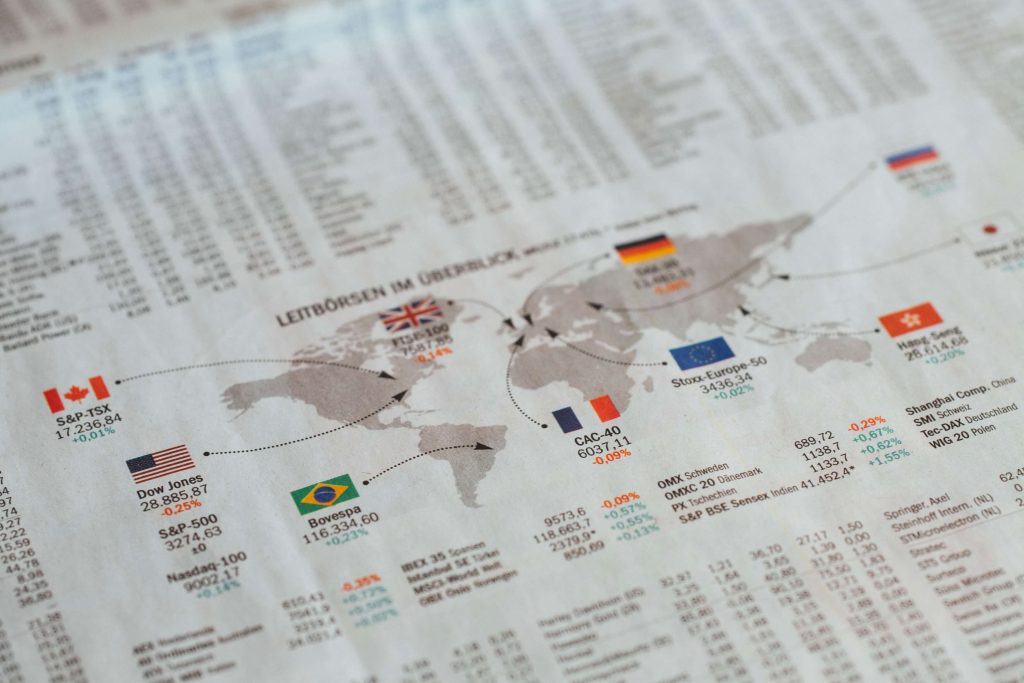The numbers reflecting the economic impact of the pandemic globally are critical, all in advanced economies, emerging markets, and developing economies. In Latin America and the Caribbean, a GDP contraction of 9.4% is expected in 2020, while for the European countries this drop is projected at 10.2% and for the United States at 8%, according to the latest data from the International Monetary Fund (IMF).
In terms of disease spread and mortality from COVID-19, the region assumes a critical role, approaching the data registered in the United States and Europe. However, countries such as Colombia and Chile are nearing the peak of cases, according to United Nations estimates, and some activities in the Colombian economy are already showing signs of reactivation. Below we present the key data on the impact of COVID-19 in five Latin American countries:
Argentina
The country’s economy was already in recession and under great uncertainty when the pandemic hit, especially due to the restructuring of public debt. The Government took containment measures that mitigated the spread of the virus, although it involved reductions in the levels of production and local demand.
In terms of the ability to contain the virus, Argentina is well off. The country – the first one in Latin America to report a death from COVID-19 – has 8,500 intensive care units, which is similar to the countries of Southern Europe. In relation to Latin American countries, Argentina has 50 hospital beds for every 10,000 people compared to 22 in Chile and Brazil, 15.2 in Mexico, and 15 in Colombia, according to the World Health Organization (data from the last available year).
As of July 1st, Argentina has 65,517 infections and 1,307 deaths from the virus; on the same day, Brazil registers 1.41 million infections and 59,745 deaths.
According to a recent report published by the Organization for Economic Cooperation and Development (OECD), the Government is working hand in hand with local companies and laboratories to increase the supply of respirators and tests. Imports of medical supplies are exempt from tariffs, and prices for food, drugs, and personal care products remain the same as in March.
The sectors most affected by the virus are entertainment, transportation, restaurants, and hotels. In turn, sales in the automotive sector and in the retail market fell almost 50% in March, where textiles, shoes, and furniture showed the largest decreases. For their part, strict capital controls keep the official exchange rate stable, but the high inflation of 50% per year hurts exports.
According to the latest OECD forecasts, with the gradual lifting of restrictions, demand levels will improve but in moderation due to lower incomes and higher unemployment. The recovery of confidence and investments in Argentina depends on the correct management of the negotiation of public debt. This factor also affects the relief on inflation and the exchange rate, indicators impacted by the measure of the Central Bank of Argentina to support the financing of the fiscal deficit.
The contraction of the Argentine GDP in 2020 will be 9.9% —the third most serious in the region after Peru with -13.9% and Mexico with -10.5% -, according to June projections from the International Monetary Fund (IMF), and recovery of 2.1% is expected for 2021.
Brazil
The pandemic came to Brazil when the country was finally recovering from a long recession, now its economic prospects foresee a contraction of 9.1% in 2020 and a recovery of 3.6% in 2021, according to the latest report from the International Monetary Fund . In addition, in terms of public health, it is the second country in the world (data updated to June 2020) with the highest number of victims and COVID-19 infections, only after the United States. As of July 1, it registers 1.41 million infections and 59,745 deaths.
The capacity of intensive care units (ICUs) is estimated at 15.6 beds per 100,000 inhabitants – compared to nine in Spain and eight in Italy – however, the occupation at the end of May had already reached its maximum limit. Unlike the majority of countries in the region, the central government, headed by Jair Bolsonaro, did not enact strict isolation measures, as opposed to many of the regional governments that did so in their territories.
During the first quarter of the year, Brazil’s GDP fell 1.5% in relation to the fourth quarter of 2019, this data interrupted four quarters of continuous growth and marked the lowest GDP figure since 2015. The industrial sector contracted by 8.2% in the first four months of 2020, with the automotive segment being the most affected, according to the Brazilian Institute of Geography and Statistics (IBGE).
According to the National Confederation of Industries (CNI), April was the month with the worst indicators for the industry. Production fell 27.2% in relation to the same period in 2019, and it also registered decreases of 23.3% in income, 19.4% in working hours, and 2.3% in the number of employees.
According to the OECD report, the degree of confidence and the expectations of purchasing managers have been strongly affected during the pandemic; retail sales based on card payments fell 30% between March 1 and May 30. The most affected sectors have been automotive, tourism, hospitality, and informal commercial activities.
Government measures to mitigate the economic impact include cuts in interest rates and a special line of credit to cover the salaries of employees who receive up to two monthly minimum wages, where 85% of credit risk is borne by the State. Additionally, investment in health and economic support to states and municipalities increased by 2% of GDP, the Government promised to create new lines of credit for companies and to cover the first 15 days of workers’ leave with COVID-19.
Unions such as the National Confederation of Industries (CNI) are confident in the progressive recovery of the economy, in turn, the Government recently signed an agreement to produce one of the most promising vaccines against COVID-19, which is currently in the testing phase.
Mexico
The new coronavirus hits Mexico hard and from different angles. Latin America’s largest economy has had to cope with falling oil prices, a freezing of the tourism sector, uncertainty in financial markets, and the breakdown of supply chains in its most robust industries.
On March 30, a month after the first positive case of COVID-19 was recorded, the central government declared a health emergency across the country. From that date, the authorities took measures to contain the outbreak, which included different degrees of voluntary isolation depending on the levels of contagion in the regions, reconversion of public and private infrastructure in hospital facilities, and agreements with the United States and China to acquire medical equipment.
As of July 1, Mexico has 226 thousand confirmed cases and 27,769 deaths due to COVID-19. The areas most affected by the virus are Mexico City, the State of Mexico, Tabasco, Veracruz, Puebla, and Baja California.
- Production
The latest analysis by the International Monetary Fund projects a contraction of GDP of 10.5% in 2020 and a recovery of 3.3 in 2021. Recently the National Institute of Statistics and Geography (Inegi) published the first data on the impact of the pandemic in Mexico: GDP fell 19.9% in April in relation to the same month of 2019; the Global Indicator of Economic Activity (IGAE) showed a decrease of 17.3% in April compared to the previous month, with seasonally adjusted figures; Industrial activity fell 25.1% from March to April; the commerce and services sector contracted 14.4%; and primary activities (agriculture, livestock, hunting, fishing, and logging) decreased 6.4% in the same period of time.
The manufacturing sector had a monthly contraction of 30.5% in April, where automotive manufacturing was the most affected with a decrease of 81.1%, followed by the segments of textile inputs (-74%), clothing manufacturing (-74%), machinery and equipment (-35%) and beverage industry (-35%). The sectors with the least impacts in this same period were the food industry (-0.2%) and that of products associated with oil (-1.8%). For its part, the construction industry had a monthly contraction of 32.8%, where construction was the most affected (-38.2%) while civil construction works fell 16.7%.
In annual terms, the IGAE had a reduction of 19.7% in April compared to the same month of 2019, with a drop of 29.6% in industrial activities and of 16.1% in trade and services; in contrast, primary activities increased 2.4%.
- Commerce
According to the Inegi in May, total exports showed an annual reduction of 56.7%, which was the result of contractions of 56.3% in non-oil exports and 63.8% in oil exports. As for non-oil exports, those destined for the United States fell 57.2% and those directed to the rest of the world fell 51.8%.
On the import side, the blow was equally hard. The value for merchandise imports in May was USD 21,592 million, an amount that represented an annual drop of 47.1%; This figure reflected the decrease of 44.3% in non-oil imports and 69.4% in oil imports. The decreases by type of goods are represented by -55.8% in imports of consumer goods, -46.7% in intermediate-use goods, and -38.3% in capital goods.
In terms of impact on employment, the most recent data from the Mexican Institute of Social Security (IMSS) account for the loss of more than one million formal jobs between April and May of this year.
Despite a large number of critical indicators, there are always opportunities in the midst of the storm. TMF Group, a business services provider, surveyed 300 executives from multinational companies in various sectors, who expressed concern about the performance of international supply chains and said they are considering moving their operations from countries such as China and Italy. Despite the uncertainty, a third of those surveyed stated that they plan to accelerate national or international commercial expansion, looking for opportunities after the pandemic, and among the countries that are considering their expansion are Canada, the United Kingdom, and Mexico.
Finally, part of the recovery expectations also lies in the entry into force, on July 1, of the trade agreement between the United States, Canada, and Mexico (T-MEC). In general terms, this agreement grants Mexico preferential access to the United States market under new trade guidelines and protection of intellectual property, as well as more stringent labor provisions that required reforms in Mexican regulations.
Colombia
The pandemic came to Colombia when the country was expecting a promising year thanks to the balance of its economy against the political and economic instability of other countries in the region. In 2019 the country had a growth rate of 3.3% compared to 0.1% in Latin America and the Caribbean, according to ECLAC data.
Given the appearance of the first cases in the first week of March, the Government took measures to contain the virus quickly, in the middle of the month the economic and social emergency was declared and for the last week the borders were closed and the entire population ( except those involved in essential activities to deal with the pandemic) was in mandatory confinement. These measures have been gradually relaxed in different regions in relation to the evolution of the virus.
The levels of daily infections and deaths remained low until mid-May in relation to other countries in the region; until that date, the deaths never exceeded 21 per day. Since then, the indicators have had greater increases and as of July 1, the country recorded 102,000 infections, with 4,149 as the maximum number on the same day, 3,470 deaths, and the capacity of ICUs in Bogotá, the city with the most registered cases, is at 71 %.
In economic terms, the country is feeling the impacts of the containment measures, the drop in oil prices, and the deficiency in the agility of government aid. The IMF forecasts a 7.8% contraction in GDP in 2020 compared to a recovery of 4% in 2021.
In the first quarter of the year, GDP fell 2.4% and for April the Economic Monitoring Indicator (ISE) registered the largest contraction in history, decreasing 20% compared to April 2019, when it showed a growth of 2.30%. In that same period, primary activities decreased by 13.75%, secondary activities decreased by 50.12%, tertiary activities fell 13.30% and exports presented an annual decrease of 52.3%.
For May, the National Administrative Department of Statistics (Dane) registered an 18.5% drop in oil production and an unemployment rate of 21.4%. For its part, the Consumer Confidence Index (ICC) registered a balance of -34%, which represented an increase of 7.3 percentage points compared to April.
The sector most affected by the isolation measures is services and the activities with the greatest impact were accommodation, food, real estate, administrative services, professional and technical activities, construction, and commerce.
The authorities ‘actions to mitigate the economic effects of the pandemic on the business sector include granting credit guarantees, deferring principal payments on existing loans, and canceling contributions to workers’ pensions.
For its part, the Central Bank reduced the interest rate by 175 basis points during 2020 (data as of June 30), the lowest in the country’s monetary history. During the announcement of the last reduction, Juan José Echavarría, general manager of the Colombian Central Bank, explained that this measure was taken on the basis that “downward reviews of local and global growth suggest a substantial expansion of excess capacity. Productive and further deterioration of the labor market, compared to the previous month ”. The executive said that the entity expects a slow recovery from Colombia’s main trading partners in the rest of the year. He also added that “the conditions of the financial markets have improved compared to the beginning of the crisis, but great uncertainty persists in the global macroeconomic context.”
Chile
The first case of the new coronavirus was detected in the first week of March and its spread was rapid, mainly affecting the Santiago Metropolitan Region, which concentrates more than 50% of COVID-19 infections. As of July 1, Chile registers 5,753 deaths and is the seventh country in the world in the number of infected with more than 282 thousand confirmed cases. According to the Pan American Health Organization (PAHO), if current conditions are maintained, the country will reach the peak of cases in mid-July.
According to a report published by the OECD in June, containment measures affect about a fifth of the economy: “hotels and restaurants, which represent 2.3% of GDP, have stopped their activity. Transportation, which represents 5% of GDP, and retail sales, which operate at 50-60% of their capacity, threaten employment in these sectors. ”
The IMF forecasts that GDP will decrease by 7.5% in 2020 and will rebound 5% in 2021. For Alejandro Werner, Director of the entity’s Western Hemisphere Department, “economic activity is expected to contract sharply in the second quarter of 2020 due to strict measures of social distancing and, to a lesser extent, to the weakening of external demand. A rebound in activity is expected for the start of the third quarter, which should continue in 2021, thanks to the unprecedented measures that have been taken in the fiscal, monetary, and financial fields. ” This projection is in line with the results disclosed by the Central Bank of Chile, which reported a 15.3% drop in the country’s economy in May compared to the same month in 2019.
According to the agency’s report, in May, when infections increased significantly in Chile, the most affected activities were services and commerce, and, to a lesser extent, manufacturing and construction; mining activity was the only one that showed growth figures.
The measures of the official entities to mitigate the economic impact to date include a temporary fiscal package, approved in March, equivalent to 4.7% of GDP, and another of 2% in April to provide liquidity to companies and support affected workers. In turn, the Government implemented a mechanism to protect labor income, and that allows the temporary suspension of contractual relations of employees when telework is not feasible.





